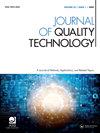Sequential Latin hypercube design for two-layer computer simulators
IF 2.2
2区 工程技术
Q2 ENGINEERING, INDUSTRIAL
引用次数: 0
Abstract
AbstractThe two-layer computer simulators are commonly used to mimic multi-physics phenomena or systems. Usually, the outputs of the first-layer simulator (also called the inner simulator) are partial inputs of the second-layer simulator (also called the outer simulator). How to design experiments by considering the space-filling properties of inner and outer simulators simultaneously is a significant challenge that has received scant attention in the literature. To address this problem, we propose a new sequential optimal Latin hypercube design (LHD) by using the maximin integrating mixed distance criterion. A corresponding sequential algorithm for efficiently generating such designs is also developed. Numerical simulation results show that the new method can effectively improve the space-filling property of the outer computer inputs. The case study about composite structures assembly simulation demonstrates that the proposed method can outperform the benchmark methods.Keywords: composites structures assembly processesGaussian processmaximin criterionoptimal LHDprincipal component scores AcknowledgmentsWe are grateful to the editor and all reviewers for their excellent work. Their constructive criticism and suggestions significantly improved the quality of this manuscript.Disclosure statementNo potential conflict of interest was reported by the author(s).Additional informationFundingThe research of Yan Wang was supported by the National Natural Science Foundation of China (Grant no. NSFC 12101024) and the work of Dianpeng Wang was supported by the National Natural Science Foundation of China (Grant no. NSFC 12171033).Notes on contributorsYan WangYan Wang is an assistant professor at the School of Statistics and Data Science, Beijing University of Technology, Beijing, China.Dianpeng WangDianpeng Wang is an assistant professor at the School of Mathematics and Statistics, and the key laboratory of mathematical theory and computation in information security, Beijing Institute of Technology, Beijing, China.Xiaowei YueXiaowei Yue is an associate professor at the Department of Industrial Engineering, and Institute for Quality and Reliability, Tsinghua University, Beijing, China.双层计算机模拟器的顺序拉丁超立方体设计
摘要双层计算机模拟器通常用于模拟多物理场现象或系统。通常,第一层模拟器(也称为内部模拟器)的输出是第二层模拟器(也称为外部模拟器)的部分输入。如何同时考虑内外模拟器的空间填充特性来设计实验是一个重大的挑战,但在文献中很少得到关注。为了解决这一问题,我们提出了一种新的序列最优拉丁超立方体设计(LHD),该设计采用了极大值积分混合距离准则。本文还提出了一种相应的序列算法来有效地生成这种设计。数值仿真结果表明,该方法可以有效地改善外部计算机输入的填充性能。对复合材料结构装配仿真的实例研究表明,该方法优于基准方法。关键词:复合材料结构装配工艺高斯过程最大准则最优lhd主成分分数感谢编辑和所有审稿人的辛勤工作。他们建设性的批评和建议大大提高了本文的质量。披露声明作者未报告潜在的利益冲突。王燕的研究得到了国家自然科学基金项目(批准号:no. 5139902)的资助。王殿鹏的工作得到国家自然科学基金(no. 12101024)资助。国家自然科学基金委12171033)。作者简介王岩,北京工业大学统计与数据科学学院助理教授。王殿鹏,北京理工大学数学与统计学院助理教授,信息安全数学理论与计算重点实验室。岳晓伟,清华大学工业工程系、质量与可靠性研究所副教授。
本文章由计算机程序翻译,如有差异,请以英文原文为准。
求助全文
约1分钟内获得全文
求助全文
来源期刊

Journal of Quality Technology
管理科学-工程:工业
CiteScore
5.20
自引率
4.00%
发文量
23
审稿时长
>12 weeks
期刊介绍:
The objective of Journal of Quality Technology is to contribute to the technical advancement of the field of quality technology by publishing papers that emphasize the practical applicability of new techniques, instructive examples of the operation of existing techniques and results of historical researches. Expository, review, and tutorial papers are also acceptable if they are written in a style suitable for practicing engineers.
Sample our Mathematics & Statistics journals, sign in here to start your FREE access for 14 days
 求助内容:
求助内容: 应助结果提醒方式:
应助结果提醒方式:


